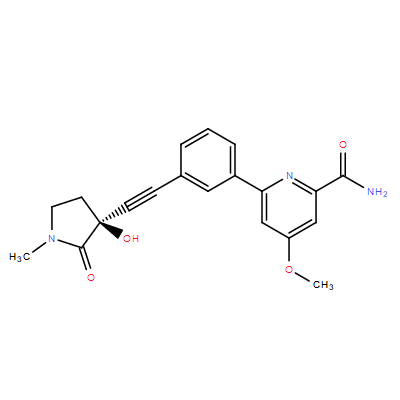| Cas No.: | 1660114-31-7 |
| Chemical Name: | (R)-6-(3-((3-Hydroxy-1-methyl-2-oxopyrrolidin-3-yl)ethynyl)phenyl)-4-methoxypicolinamid |
| SMILES: | C(C(N)=O)1=NC(C2=CC=CC(C#C[C@](O)3CCN(C)C3=O)=C2)=CC(OC)=C1 |
| Formula: | C20H19N3O4 |
| M.Wt: | 365.38 |
| Purity: | >98% |
| Sotrage: | 2 years -20°C Powder, 2 weeks 4°C in DMSO, 6 months -80°C in DMSO |
| Publication: | 1. Brightbill HD, et al. Nat Commun. 2018 Jan 12;9(1):179. |
| Description: | NIK SMI1 is a potent, selective NF-κB inducing kinase (NIK) inhibitor, which inhibits NIK-catalyzed hydrolysis of ATP to ADP with IC50 of 0.23±0.17 nM. |
| Target: | NIK[1] |
| In Vivo: | C57BL/6 mice are treated twice daily for 7 days with orally administered NIK SMI1 or with three injections of recombinant BAFF receptor fusion protein (Br3- mIgG2a) over the course of the 7-day experiment as a positive control. The nonlinearity of exposure relative to dose between 100 and 200 mg/kg is a result of saturation of clearance mechanisms. The pharmacology of NIK SMI1 is examined in SD rat, CD-1 mouse, beagle, and cynomologous monkey with 20, 32, 18, and 7.8 mL/kg per min, respectively. Volume of distribution (Vd, L/kg) is 1.35, 1.58, 0.778, and 1.39, respectively[1]. |
| In Vitro: | NIK SMI1 (Compound 4f) inhibits NIK-catalyzed hydrolysis of ATP to ADP (fluorescence polarization, FP) with an IC50 of 0.23±0.17 nM. NIK SMI1 inhibits the expression of NIK SMI1 response elementregulated firefly luciferase reporter gene in HEK293 cells with an IC50 of 34±6 nM. Consistent with expectations for a NIK inhibitor, NIK SMI1 is shown to inhibit nuclear translocation of p52 (RelB) (IC50=70 nM). NIK SMI1 inhibits BAFF-induced B cell (mouse) survival in vitro with an IC50 of 373±64 nM[1]. |
| Cell Assay: | Human B cells are re-suspended in RPMI with 10% FBS for the proliferation assays and 2.5% FBS for the survival assays. Mouse B cells are plated in Co-star 96-well plates at either 50,000 cells/well for the survival assays or at 150,000 cells/well for the proliferation assays. Compounds (e.g., NIK SMI1) diluted in DMSO (final DMSO assay concentration=0.1%) are added to the cells. The cells are incubated with NIK SMI1 (10-9 nM, 10-7 nM, 10-5 nM, 10-3 nM, 0.1 nM, and 10 nM) for one hour at 37°C. Stimulus is then added to the plates and survival or proliferation is measured after four days. For the proliferation assays, cells are treated with either Anti-IgM (20 µg/mL) or rhCD40L (10 µg/mL) or anti-mouse CD40 (100 ng/mL). For the BAFF survival assay, cells are treated with human or mouse rBAFF at 10 ng/mL followed by Cell Titer Glo to measure survival on day four[1]. |
| Animal Administration: | Mice[1] Age-matched C57BL/6 mice are used. Only female mice are used in these experiments. The single oral doses of NIK SMI1 are 10, 20, 60, 100, and 200 mg/kg. For PO dosing, animals are manually restrained, then dosed via oral gavage using an appropriately sized gavage needle. Animals are monitored for any signs of aspiration or distress-respiratory abnormalities, lethargy, pale extremities, etc. For sample collection, 3 mice per group are bled a total of 8 times via tail prick using a 27 G needle (lateral tail vein). 10 μL of blood is collected at each timepoint and deposited into a pre-filled costar cluster tube containing 40 μL of 1.7 mg/mL EDTA/water, the tube is capped, votexed for 5 seconds, then stored on dry ice. Samples are transferred to a -80°C freezer for storage[1]. |
| References: | [1]. Blaquiere N, et al. Scaffold-Hopping Approach To Discover Potent, Selective, and Efficacious Inhibitors of NF-κB Inducing Kinase. J Med Chem. 2018 Aug 9;61(15):6801-6813. |

 DC Chemicals' products qualify for U.S. tariff exemptions. We guarantee no price increases due to customs duties and maintain stable supply, continuing to deliver reliable research solutions to our American clients.
DC Chemicals' products qualify for U.S. tariff exemptions. We guarantee no price increases due to customs duties and maintain stable supply, continuing to deliver reliable research solutions to our American clients.





















